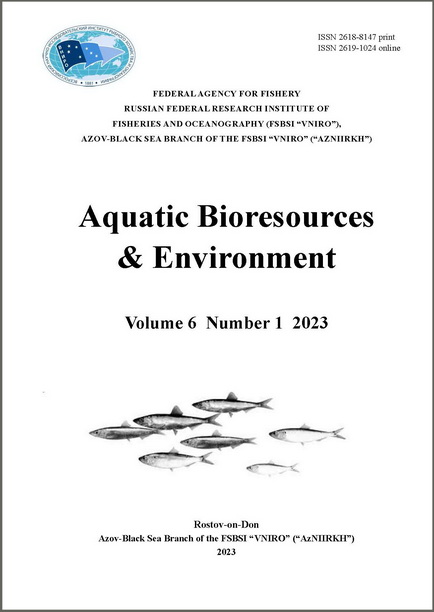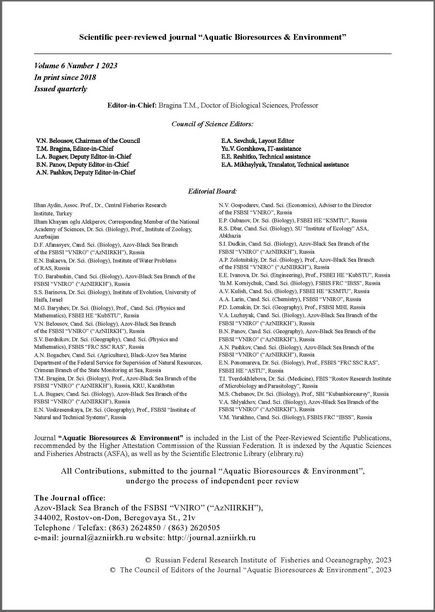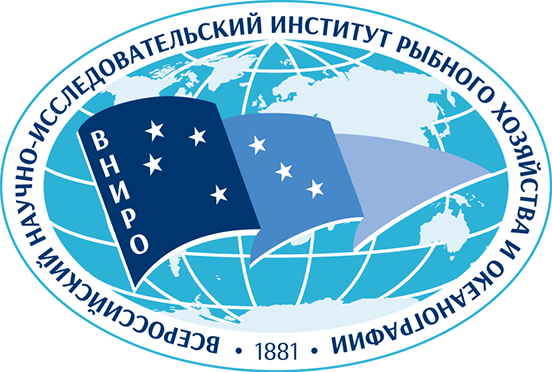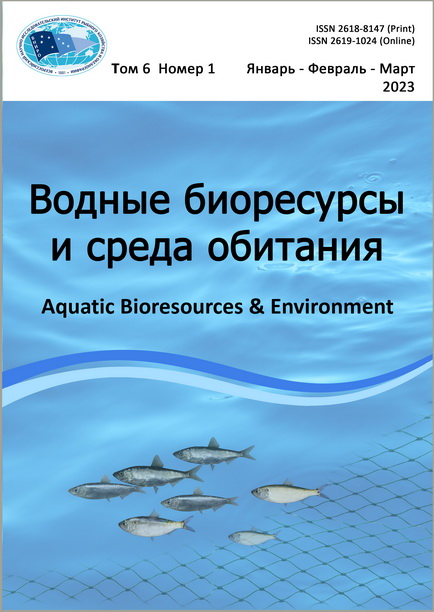

Environmental Concerns and the State of Aquatic Environment
fungicide on various links of the trophic chain in a model experiment
O. A. Zinchuk,I. B. Baimova, T. N. Karpushova, L. M. Besschetnova
Abstract. Currently, there is an ongoingprocess of developmentof the next-generation pesticides, which use for the purposesof agriculture has negative implications for the environment. Their hazard potential is attributable to two factors:high biological activityand their application method involving their dispersion in the environment. It necessitates the investigation of the effect of pesticides on aquatic organisms, which includes changes in their habitat,disruptions of their vital functions, especially at the early stages of their ontogeny, accumulation in their tissues,and movement along the trophicchain. Toxicological assessment of the fungicide Cayunis, EC effect has been conducted on the aquatic organisms of various taxonomicgroups: microalgae (Scenedesmus guadricauda (Turpin) Brébisson, 1835), macrophytes (Elodea canadensis Michaux, 1803), molluscs (Planorbarius corneus(Linnaeus, 1758)), embryos and fry of the round goby (Neogobius melanostomus (Pallas, 1814)). Over the course of the experiment, the conditions for intoxication were identified, and the toxicometric characteristics of the aquatic organisms belonging to varioustrophic levels were estimated. Using an experimental approach, the thresholdand no observed effect concentrations of the preparative form of Cayunis,EC pesticide have been identified for each test subject. This study made it possibleto compare the sensitivity of each investigated test subject to the fungicide. Among the studied test subjects,round goby fry has proved to be the most sensitive to the effect of Cayunis, EC fungicide.
Keywords: pesticides, fungicide, aquatic organisms, survivalrate
Assessment of the physicochemical
properties of the main rivers of the Mekong Delta and their ecological zoning
E. P. Karpova, Cu Nguyen Dinh, S. V. Statkevich, TruongBa Hai, I. I. Chesnokova,
S. V. Kurshakov, E. R. Ablyazov, E. E. Slynko, Duong Thi Kim Chi
Abstract. The Mekong Delta is one of Asia'slargest megadeltas. It is a region with unique biodiversity and the main food source for a large part of the population of Vietnam and Cambodia. The decrease in the biodiversity and resource capacity of the delta, associated with the growth of anthropogenic impact and other negative environmental factors, requires effort to maintainits ecosystem in a state favorable for the life of aquaticorganisms, for which the first step is to organizeeffective monitoring of aquatic communities. Its organization must consider the complex structureof the delta and relatedfeatures of the physicochemical characteristics of the habitat. The mean and intervalvalues of the parameters were as follows:transparency was 47.7±16.4(10–100) cm; in the surfacewater layer, the temperature was 29.7±1.37 (26.0–33.3) °C, electrical conductivity was 5490.4±8392.5 (133–33623) µS/cm, total dissolvedsolids were 3556.2±5445.8 (86.5–21853), pH was 7.6±0.3 (6.9–8.4), and dissolved oxygen was 4.8±1.05 (3.0–8.9) mg/L; in the bottom water layer, the temperature was 29.6±1.43 (26.0–34.1) °C, electrical conductivity was 7671.4±11193.2 (125–37870) µS/cm, total dissolvedsolids were 4905.3±7199.8 (78.0–24615.5), pH was 7.6±0.3 (6.9–8.2), and dissolved oxygen was 4.6±1.00 (2.6–7.7) mg/L. The zoning of the delta based on the knowledge of the environment makes it possibleto organize the monitoring processin the most rational way. Following the results of the analysisof physicochemical parameters, the boundaries of zones with different environmental conditions that affect the formation of fish communities have been determined. The main contributing factors are salinity(3 zones), oxygen regime (3 zones), and runoff distribution (4 zones). The interrelation between the delta zoning according to the hydrochemical regime and the structural features of the fish communities at the family level has been found, which further supports the idea that such zoning must be taken into consideration when organizing monitoring surveys.
Keywords: Mekong, delta,ecological factors, water parameters, fish communities, zoning
The influence of water salinity on generation of near-bottom hypoxic phenomena and the level of
primary production of organic matter in Taganrog Bay
Yu. V. Kosenko, T. E. Baskakova, S. V. Zhukova,
T. O. Barabashin, M. M. Piatinskii
Abstract. Atpresent, the Azov Sea ecosystem exists in the context of continuously decreasing continental runoff and increasing water salinity, which reached in 2020–2021 the highest valuesfor the entire period of observations since 1962. The increase in water salinityinevitably leads to the transformation in the composition of biological communities, which has a pronounced effect on the environment and fisheries. This paper discussesthe long-term impact of water salinity on the development of near-bottom hypoxicphenomena and on the volume of primaryproduction of organicmatter by phytoplankton in Taganrog Bay during the summer season (1962–2021). A statistical ecosystemanalysis describing the contribution of the major hydrological and hydrochemical factorsinto the processesof hypoxia formationin the bottom water layer of TaganrogBay has been performed. It is shown that the desalinization of the waters of TaganrogBay in 1993–2008 was accompanied by the increasein the size of hypoxiczones in the bottom waterlayer. During the modern period of salinization extending from 2009 to the present, there has been recorded a decrease in the scale of oxygen deficiency in Taganrog Bay. The most crucial contribution to the hypoxicprocesses in Taganrog Bay is provided by the stability of water masses, water temperature, organic nitrogen concentration, and the water salinity (due to the effect of salinity on the stabilityof water masses).During the streaks of Taganrog Bay salinization, the decrease in the stability of water masses and in the content of organicnitrogen and phosphorus in the water (crucial factorsin the formation of hypoxiczones) has been recorded. The highest rates of the primary production of organic matter by phytoplankton in Taganrog Bay were observed during the desalinization period of 1962–1968, and the lowest ones were recorded during the salinization periods. The results of this assessment have exposed the significant relationship: the primary production of organic matter depends on the average annual runoff of the Don River, the water salinity, and the concentration of mineral nitrogen.
Keywords: Taganrog Bay, salinity, Don River runoff, hypoxic zones, prima ryproduction, biogenic substances, water stability, ecosystem analysis
Specific features of spatial distribution of hydrochemical
parameters in the Curonian Lagoon of the Baltic Sea in 2018–2022
A. V. Stashko, S. V. Aleksandrov
Abstract. Curonian Bay of the Baltic Sea is a lagoon that is considered to be a water body of the highest fisheries importance. Its current geoenvironmental status is characterized by a number of problems: influx of biogenicsubstances from a large catchmentarea, algal bloom, etc. As part of the monitoring surveys of the habitat of aquatic living resources that were conducted in Russian waters of Curonian Lagoon in 2018– 2022, the spatial distribution of hydrochemical parameters was investigated in 6 areas established on the basis of their morphometric and hydrological features: Teply (Warm) Bay, western, central, eastern, and southernareas, and the Neman River discharge zone. Hydrochemical conditions in Teply Bay were characterized by a considerable deviation of dissolved oxygen concentrations from the rest of Russian waters of Curonian Lagoon,as well as by the higher values of BOD5 and ammonia nitrogen,and lower values of pH and nitratenitrogen. In the western area, the lowest content of dissolved oxygen,BOD5, ammonia, and nitrate nitrogen was recorded.In the southern area, there was a reduced content of ammonia nitrogen and nitrate nitrogen.In the central area, the values of hydrochemical parameters were close to the average ones for Russian waters. The eastern and Neman River discharge areas, exposed to significant influence of the Neman River runoff,were characterized by a high concentration of nitrate nitrogen during seasonal flood, as well as by increased values of ammonia nitrogen and BOD5 during algal bloom in summer.
Keywords: Curonian Lagoon, eutrophication, oxygen conditions, biochemical oxygen demand, nutrients, algal bloom
Biology and Ecologyof Aquatic Organisms
Polychaeta taxocene in the coast al area of Lake Donuzlav
V. G. Kopiy
Abstract. This work is based on the data collected during the benthicsurvey of soft sediments in the coastal area of Lake Donuzlav conductedin August, 2020. The currentstatus of the species composition of polychaetes in Lake Donuzlavwas investigated. The samples were collected using a manuallyoperated grab samplerwith a capture area of 0.04 m2 at the depths from 1 to 8 m. The followingindicators were used to describethe quantitative development of benthos: abundance, biomass, occurrence, densityindex, and Czekanowski–Sørensen index. A total of 31 species of polychaetes have been found. The average values of polychaetes abundance and biomassin the investigated area were 239±51 ind./m2 and 1.537±
0.599 g/m2, respectively. The main contribution to the total abundance is made by Spio decorata, and to the total biomassby Lagis neapolitana. The largest number of species and the highest abundance were recorded at the depths of 1.1–2 m. The largest biomass was recorded at the depths of 6.1–7 m. The ranked series according to the densityindex is headed by L. neapolitana, Glycera tridactyla, and S. decorata. The trophic structure of polychaetes is represented by poly-, phyto-,detritophages, carnivores, and the animals,the food spectrumof which has not been studied. The most widely represented group is carnivores; it comprises 10 species of polychaetes. The least number of species (1) was recorded for phytophages. Over 1990–2020, 73 species of polychaetes were identified; they belonged to 29 families and 56 genera.
Keywords: polychaetes, Lake Donuzlav, Black Sea, trophic structure
under the impact of copper (II) ions
E. L. Nevrova, A. N. Petrov
Abstract. Copper compounds accumulate in marine bottom sediments as the result of human activity and, being highly toxic, affect microphytobenthos. Evaluation of the tolerance ranges of benthic diatoms to copper pollution is important for biotesting and assessment of coastal marine environment. This work is aimed to reveal the dynamics of growth and cell death of marine benthic diatom Pleurosigmaaestuarii (Bréb. in Kütz.) W. Smith, 1853 under the impact of a wide range of copper (II) ions concentrations over the course of a 10-day experiment in clonal culture,as well as to identifya tolerance thresholdfor this species,critical for its survival when exposed to the toxicant.The study has focused on assessment of the changes in the proportion (%) of alive cells, absolute cell number and specific growth rate of the culture at different exposure durations and concentrations of Cu2+ ions (32–1024 μg/L) and was meant to evaluate the applicability of this species as a new test object for ecotoxicology. In the control culture and in the cultures exposed to Cu2+ in the range of concentrations 32–256 μg/L, the proportion of alive cells did not change over the course of the experiment (95–99 %). At Cu2+ concentration 320 μg/L, the proportion of alive cells decreased to 23 % on the 3rd day and to 10 % on the 5th day, which provideda basis to consider this value as a thres holdone for P. aestuarii survival. At Cu2+ concentrations 384 μg/L and higher,up to the maximum one (1024μg/L), drastic inhibition of the culture was recorded as early as on the 1st day, and on the days 3–5, all the cells died. The increasein the absolute cell number in the concentration range 32–256 μg/L was consistent with the dose–response sigmoidmodel. Over the timespan of days 1–7, the cell number increased by 3–5 times, reaching its maximum, and then it decreased by 10–12 % by the 10th day. At Cu2+ concentrations 320 μg/L and higher, the increasein the cell number was strongly suppressed since the 1st day. Within the 32–256 μg/L range, the test culture is characterized by positive specific cell growth rate for the period up to 7 days; at the thres hold concentration 320 µg/L and higher,this test parameter becomes negative. Thus, P. aestuariishould be recommended as a new appropriate test object both for toxicological experiments and for monitoring of coastal marine environment affected by technogenic pollution.
Keywords: toxicology, biotesting, clon al culture, diatoms, monitoring, pollution, Black Sea
Transformation of the polychaete taxocene in the
shallow part of Karkinit Bay under conditions of changing salinity
D. V. Podzorova, N. A. Boltachova
Abstract. Karkinit Bay is the largest bay of the Black Sea. Since the 1960s, after the construction of the North Crimean Canal, the water in the top of the bay was heavilydesalinated by runoff from fish ponds and irrigation systems.In 2014, after the canal was blocked,the salinity of the water increased, and the living conditions of the organismschanged. This work is aimed at the assessment of the change in the species composition and quantitative characteristics of the polychaete taxocene in the shallow zone of KarkinitBay in 2018, which resultedfrom the changesin water salinity,as compared to those in 2008. The studies were carried out in August of 2008 and 2018—in three sampling areas at 17 stations (in 2008 and 2018 alike) at depths of 0.2–1.7m. Samples of macrozoobenthos were collected using a manual bottom grab with a sample area of 0.04 m2. In the top part of Karkinit Bay in the first half of the 21st century,35 species of polychaetes were recorded. Polychaete worms belonging to 19 familie shave been identified, with the families Phyllodocidae, Syllidae, Nereidae, and Spionidae comprising the largest number of species (4 species each). Three species—Lysidice unicornis, Polyophthalmus pictus, Syllis prolifera—were recorded in Karkinit Bay for the first time. It is shown that, with the post-2014 increase in salinity, the species richness of the polychaete taxocene in the investigated area has also increased. In 2008, 24 specieswere found, and in 2018, 32 species. The average abundance of polychaetes in 2008 was 948± 345 ind./m2, and in 2018, it was 417±161 ind./m2. Hediste diversicolor reached the high est abundance in 2008 (average abundance 676±371 ind./m2, maximum abundance 2313 ind./m2). In 2018, Polydora cornuta(600 ind./m2), Platynereisdumerilii (225 ind./m2), and Scolelepis tridentata (450 ind./m2) were characterized by the highest abundance. With an increase in salinity in the range of 1.5–17.8 ‰, a decrease in the density of H. diversicolor was recorded and, conversely, an increase in the density of other Polychaeta species.
Keywords: Karkinit Bay, Polychaeta, Hediste diversicolor, species composition, frequency of occurrence, abundance
Ichthyofauna of Marine and Inland Water Bodies
Catch composition of the European anchovy(Engraulis encrasicolus L., 1758), wintering off the coast
of Abkhazia in the 2021/2022 fishing season
R. S. Dbar, P. D. Gamakharia
Abstract. Based on the available data for the 2021/2022 fishing season, the ecological structure and fishing biological parameters of the European anchovy(E. encrasicolus L., 1758), wintering in the coastal waters of Abkhazia, have been analyzed. This paper presents materials that make it possible to analyze the dynamic parameters of the Azov and Black Sea stocks of the European anchovy aggregating off the coast of Abkhaziain the winter season. A comparative analysis of the main biometric parameters has been carriedout. For data analysis, well-established ichthyological methods have been used. The availabledata on the European anchovy(both Black Sea and Azov Sea forms) caught during the investigated period characterize the dynamics of the length–age catch composition and are indicative of its intra-annual fishing patterns. Changesin the population characteristics presentin the catch composition as compared with the previousyears have been identified. The absolute catch values and their fluctuations are presented by the month. Analysis of the available material has indicatedthe main dynamic changes that characterize the wintering anchovy population as stable with a tendency for its total biomass development on a moderate level, which is not conducive for increasing the fishing effor tin the next 1–2 years.
Keywords: European anchovy, Azov and Black Sea form of anchovy, length–age catch composition, fishery dynamics, Abkhazia
Fisheries and Processing of Aquatic Bioresources
A. M. Stafikopulo, N. V. Vtyurina, Ya. I. Gorbatyuk
Abstract. This paper presents the main fishing methods and gears previously used or appraised and currently applied in the course of BlackSea–Caspian sprat (tyulka) fishing in the Azov Sea: their performance, merits and demerits. Black Sea–Caspian sprat (tyulka) fishing comprises the coastal fishing with pound nets and the fishing off the board of fishing vessels with purse seines ans midwatertrawls. Recently, sprat catches with pound nets have been on the decline; meanwhile, use of fishing vessels, albeit more resource-consuming and dependent on the multitudeof factors, can prospectively be more productive than the coastalfishing, even though currently it shows lower catches. A brief characterization of the Black Sea–Caspian sprat (tyulka) industrial fishing in the recent years is given, its trends and challenges are discussed. Daily vessel reportshave been processedfor 2015–2021, and the comparative data on the operation of the vesselsof various types are presented; the trends in the changingindustrial fishing parameters during the investigated period show a considerable decreasein all the parameters. Another crucial issue is the necessity to reduce the by-catch of non-target fish species (sturgeons, Black Sea turbot)in long-continued depressed state with midwatertrawls. The presented data will allow for the current status assessment of the Black Sea–Caspian sprat (tyulka) industrial fishing and envisioning the efficient, yet selective and environmentally sound fishing methods to be developed and revised.
Keywords: Azov Sea, industrial fishing, coastal fishing,fishing gear, Black Sea–Caspian sprat (tyulka), purse seine, midwater trawl, fishing with light attractor,types of vessels,fishing parameters, fishing effort
Informational Messages
Brief Guidelines for the Authors



